McDonnell Douglas F15 Eagle Video - Ultimate Strike Planes - Discovery Channel - Part 1
|
|
|
|
| Maximum speed: -High altitude: Mach 2.5+ (1,650+ mph, 2,660+ km/h) -Low altitude: Mach 1.2 (900 mph, 1,450 km/h) Combat radius: 1,061 nmi (1,222 mi, 1,967 km) for interdiction mission Ferry range: 3,450 mi (3,000 nmi, 5,550 km) with conformal fuel tanks and three external fuel tanks Service ceiling: 65,000 ft (20,000 m) |
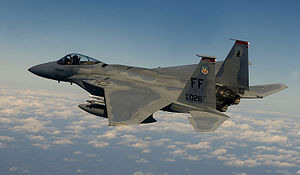
Role: Air superiority fighter
Manufacturer: McDonnell Douglas, Boeing IDS
First flight: 27 July 1972
Introduction: 9 January 1976
Status: Active
Primary users: United States Air Force, Israeli Air Force, Japan Air SelfDefense Force, Royal Saudi Air Force
Unit cost: F15A/B: US$27.9 million (1998), F15C/D: US$29.9 million (1998)[1]
Variants: F15E Strike Eagle, F15 S/MTD
The McDonnell Douglas (now Boeing) F15 Eagle is a twinengine, allweather tactical fighter designed to gain and maintain air superiority in aerial combat. It was developed for the United States Air Force, and first flew in July 1972. It is one of the most recognized fighters of the modern day. The F15E Strike Eagle derivative is an allweather strike fighter that entered service in 1989. The U.S Air Force plans to keep the F15 in service until 2025.[2]
Development
Origins
In 1967 U.S. intelligence was surprised[3] to find that the Soviet Union was building a large fighter aircraft, known as the MiG25 'Foxbat'.[4] It was not known in the West at the time that the MiG25 was designed as a highspeed interceptor, (not an air superiority fighter),[5] so its primary asset was speed, not maneuverability. The MiG25's huge tailplanes and vertical stabilizers (tail fins) hinted at a very maneuverable aircraft, which worried the Air Force that its performance might be higher than its American counterparts. In reality, the MiG's large fins and stabilators were necessary to prevent the aircraft from encountering inertia coupling in highspeed, highaltitude flight.
The F4 Phantom II of the USAF and U.S. Navy was the only fighter with enough power, range, and maneuverability to be given the primary task of dealing with the threat of Soviet fighters while flying with visual engagement rules.[4] As a matter of policy, the Phantoms could not engage targets without positive visual identification, so they could not engage targets at long ranges, as designed. Mediumrange AIM7 Sparrow missiles, and to a lesser degree even the AIM9 Sidewinder, were often unreliable and ineffective at close ranges where it was found that guns were often the only effective weapon.[6] The Phantom did not originally have a gun, but experience in Vietnam led to the addition of a gun. An external gun pod was tried and later the M61 Vulcan was integrated internally on the F4E.
FX program
There was a clear need for a new fighter that overcame the closerange limitation of the Phantom while retaining longrange air superiority. After rejecting the U.S. Navy VFX program (which led to the F14 Tomcat) as being unsuited to its needs, the U.S. Air Force issued its own requirements for the Fighter Experimental (FX), a specification for a relatively lightweight air superiority fighter.[7] The requirements called for singleseat fighter having a maximum takeoff weight of 40,000 lb (18,100 kg) for the airair role with a maximum speed of Mach 2.5 and a thrust to weight ratio of nearly 1 at mission weight.[8] Four companies submitted proposals, with the Air Force eliminating General Dynamics and awarded contracts to Fairchild Republic, North American Rockwell, and McDonnell Douglas for the definition phase in December 1968. The companies submitted technical proposals by June 1969. The Air Force announced the selection of McDonnell Douglas on 23 December 1969.[9] The winning design resembled the twintailed F14, but with fixed wings. It would not be significantly lighter or smaller than the F4 that it would replace.
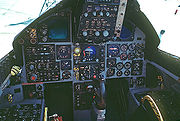 (Image: F-15A cockpit)
(Image: F-15A cockpit)
The Eagle's initial versions were designated F15A for the singleseat configuration and F15B (originally TF15A, but this designation was quickly deprecated, as the F15B is fully combatcapable) for the twinseat. These versions would be powered by new Pratt & Whitney F100 engines to achieve a combat thrusttoweight ratio in excess of 1 to 1. A proposed 25 mm FordPhilco GAU7 cannon with caseless ammunition was dropped in favor of the standard M61 Vulcan gun due to development problems. The F15 retained conformal carriage of four Sparrow missiles like the Phantom. The fixed wing was put onto a flat, wide fuselage that also provided an effective lifting surface. Some questioned if the zoom performance of the F15 with Sparrow missiles was enough to deal with the new threat of the highflying MiG25 "Foxbat", but its capability was eventually demonstrated in combat.
(Image: McDonnell Douglas F15A (S/N 710280) first flight.)
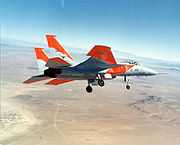 The first F15A flight was made in July 1972 with the first flight of the twoseat F15B (formerly TF15A) following in July 1973.[10]
The first F15A flight was made in July 1972 with the first flight of the twoseat F15B (formerly TF15A) following in July 1973.[10]
The F15 has a "lookdown/shootdown" radar that can distinguish lowflying moving targets from ground clutter. The F15 would use computer
technology with new controls and displays to lower pilot workload and require only one pilot to save weight. Unlike the F14 or F4, the F15 has
only a single canopy frame with clear vision forward. The USAF introduced the F15 as "the first dedicated USAF air superiority fighter since
the F86 Sabre."[11]
USAF F15C taxiing for takeoff.
The F15 would be favored by customers such as the Israel Air Force and Japan Air SelfDefense Force, and the development of the F15E Strike Eagle would produce a strike fighter that would replace the F111. However, criticism from the fighter mafia that the F15 was too large to be a dedicated dogfighter, and too expensive to procure in large numbers to replace the F4 and A7, led to the Lightweight Fighter (LWF) program, which led to the USAF F16 Fighting Falcon and the middleweight Navy F/A18 Hornet.
The singleseat F15C and twoseat F15D models entered production in 1978 with the models' first flights in February and June of that year.[12] These new models have Production Eagle Package (PEP 2000) improvements, including 2,000 lb (900 kg) of additional internal fuel, provision for carrying exterior conformal fuel tanks and increased maximum takeoff weight of up to 68,000 lb (30,700 kg).[13]
Improvements
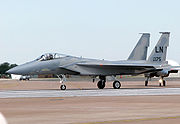 (Image:
USAF F-15C taxiing for takeoff)
(Image:
USAF F-15C taxiing for takeoff)
The F15 Multistage Improvement Program (MSIP) was initiated in February 1983 with the first production MSIP F15C produced in 1985. Improvements included an upgraded central computer; a Programmable Armament Control Set, allowing for advanced versions of the AIM7, AIM9, and AIM120A missiles; and an expanded Tactical Electronic Warfare System that provides improvements to the ALR56C radar warning receiver and ALQ135 countermeasure set. The final 43 included the enhancedcapability Hughes APG70 radar, which was carried forward into the F15E. The earlier MSIP F15Cs with the APG63 were later upgraded to the APG63(V)1, which significantly improves reliability and maintainability while providing performance similar to the APG70. The improvements were retrofitted to existing F15s.[14]
Design
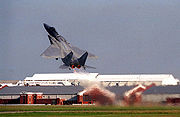 (Image:
F-15C performing a maximum performance takeoff)
(Image:
F-15C performing a maximum performance takeoff)
The F15 has an allmetal semimonocoque fuselage with a large cantilever shouldermounted wing. The empennage is allmetal twin fins and rudders with allmoving composite horizontal tail surfaces outboard of the fins. The F15 has a spinemounted air brake and retractable tricycle landing gear. It is powered by two Pratt & Whitney F100 axialflow turbofan engines with afterburners mounted sidebyside in the fuselage. The cockpit is mounted high in the forward fuselage with a onepiece windscreen and large canopy to increase visibility.
The F15's maneuverability is derived from low wing loading (weight to wing area ratio) with a high thrusttoweight ratio enabling the aircraft to turn tightly without losing airspeed. The F15 can climb to 30,000 ft (10,000 m) in around 60 seconds. The thrust output of the dual engines is greater than the aircraft's weight, thus giving it the ability to accelerate in a vertical climb. The weapons and flight control systems are designed so that one person can safely and effectively perform airtoair combat.[7] The "A" and "C" models are singleseat variants that make up the bulk of F15 production. "B" and "D" models add a second seat behind the pilot for training. "E" models use the second seat for a bombardier/navigator.
A multimission avionics system includes a headup display (HUD), advanced radar, inertial guidance system (INS), flight instruments, ultra high frequency (UHF) communications, and Tactical Air Navigation (TACAN) and Instrument Landing System (ILS) receivers. It also has an internally mounted, tactical electronicwarfare system, "identification friend or foe" system, electronic countermeasures suite and a central digital computer.[15]
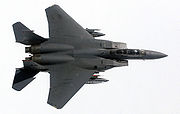 (Image:
A wing over maneuver displays the clean lines and high-wing design of an F-15E from Elmendorf AFB, AK.)
(Image:
A wing over maneuver displays the clean lines and high-wing design of an F-15E from Elmendorf AFB, AK.)
The headsup display projects, through a combiner, all essential flight information gathered by the integrated avionics system. This display, visible in any light condition, provides the pilot information necessary to track and destroy an enemy aircraft without having to look down at cockpit instruments.[16]
The F15's versatile APG63/70 PulseDoppler radar system can look up at highflying targets and down at lowflying targets without being confused
by ground clutter. It can detect and track aircraft and small highspeed targets at distances beyond visual range (the maximum being 120 nautical
miles (220 km) away) down to close range, and at altitudes down to treetop level. The radar feeds target information into the central computer
for effective weapons delivery. The capability of locking onto targets as far as 50 nautical miles (90 km) with an AIM120 AMRAAM enables true beyond
visual range (BVR) engagement of targets. For closein dogfights, the radar automatically acquires enemy aircraft, and this information is projected
on the headup display. The F15's electronic warfare system provides both threat warning and automatic countermeasures against selected threats.[17]
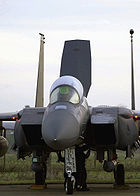 (Image:
A wing over maneuver displays the clean lines and high-wing design of an F-15E from Elmendorf AFB, AK.)
(Image:
A wing over maneuver displays the clean lines and high-wing design of an F-15E from Elmendorf AFB, AK.)
A variety of air-to-air weaponry can be carried by the F15. An automated weapon system enables the pilot to perform aerial combat safely and effectively, using the headup display and the avionics and weapons controls located on the engine throttles or control stick. When the pilot changes from one weapon system to another, visual guidance for the required weapon automatically appears on the headup display.[18]
The Eagle can be armed with combinations of four different airtoair weapons: AIM7F/M Sparrow missiles or AIM120 AMRAAM advanced medium range airtoair missiles on its lower fuselage corners, AIM9L/M Sidewinder or AIM120 missiles on two pylons under the wings, and an internal M61A1 20 mm Gatling gun in the right wing root.[19]
Lowdrag conformal fuel tanks (CFTs) were developed for the F15C and D models. They can be attached to the sides of the engine air intake trunks
under each wing and are designed to the same load factors and airspeed limits as the basic aircraft.[19] However, they degrade performance by increasing
drag and cannot be jettisoned inflight (unlike conventional external tanks). Each conformal fuel tank can hold 750 U.S. gallons (2,840 L) of fuel.[20]
These tanks increase range thus reducing the need for inflight refueling. All external stations for munitions remain available with the tanks in
use. Moreover, Sparrow or AMRAAM missiles can be attached to the corners of the conformal fuel tanks.[13] The 57 FIS based at Keflavik NAS, Iceland
was the only Cmodel squadron to utilize CFT's on a regular basis due to its extended operations over the North Atlantic. With the closure of the
57 FIS the F15E is the only U.S. variant to carry them on a routine basis. The American CFTs were also provided to Israel and Saudi Arabia but
only Israel uses them (as needed) on their entire fleet.
M61 Vulcan mounted on the side of right engine intake.
(Image:
M61 Vulcan mounted on the side of right engine intake.)
The F15E Strike Eagle is a twoseat, dualrole, totally integrated fighter for allweather, airtoair and deep interdiction missions. The rear cockpit is upgraded to include four multipurpose CRT displays for aircraft systems and weapons management. The digital, tripleredundant Lear Siegler flight control system permits coupled automatic terrain following, enhanced by a ringlaser gyro inertial navigation system.[21] For lowaltitude, highspeed penetration and precision attack on tactical targets at night or in adverse weather, the F15E carries a highresolution APG70 radar and LANTIRN pods to provide thermal imagery.[17]
The APG63(V)2 Active Electronically Scanned Array (AESA) radar has been retrofitted to 18 U.S. Air Force F15C aircraft.[22] This upgrade includes most of the new hardware from the APG63(V)1, but adds an AESA to provide increased pilot situational awareness. The AESA radar has an exceptionally agile beam, providing nearly instantaneous track updates and enhanced multitarget tracking capability. The APG63(V)2 is compatible with current F15C weapon loads and enables pilots to take full advantage of AIM120 AMRAAM capabilities, simultaneously guiding multiple missiles to several targets widely spaced in azimuth, elevation, or range.
Operational history
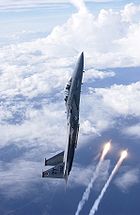 (Image:
F-15D from the 325 Fighter Wing based in Tyndall AFB, releasing flares)
(Image:
F-15D from the 325 Fighter Wing based in Tyndall AFB, releasing flares)
The largest operator of the F15 is the United States Air Force. The first Eagle (F15B) was delivered November 14, 1974.[23] In January 1976, the first Eagle destined for a combat squadron, the 555th TFS, was delivered.[23] These initial aircraft carried the Hughes Aircraft (now Raytheon) APG63 radar.
The first kill in an F15 was by IAF ace Moshe Melnik in 1979.[24] In 1979–81 during IsraeliLebanese border disputes, F15As downed 13 Syrian MiG21 "Fishbeds" and two Syrian MiG25 "Foxbats", the latter being the aircraft the F15 was designed to kill. F15A and B models were used by Israel during the Bekaa Valley operation. During the 1982 Lebanon War, the Israeli F15s shot down 40 Syrian jet fighters (23 MiG21 "Fishbeds" and 17 MiG23 "Floggers") and one Syrian SA.342L Gazelle helicopter.[25] Later on, in 1985, IAF Eagles, in Operation Wooden Leg, bombed the PLO headquarters in Tunisia.[26] This was one of the few times air superiority F15s (A/B/C/D models) were used in tactical strike missions.
Royal Saudi Air Force F15C pilots shot down two F4E Phantom IIs flown by the Iranian Air Force in a skirmish in June 1984, and shot down two Iraqi
Mirage F1s during the Gulf War.[27][28][29]
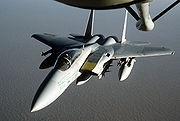 (Image:
A Royal Saudi Air Force F-15 approaches a KC-135 for refueling during Operation Desert Shield.)
(Image:
A Royal Saudi Air Force F-15 approaches a KC-135 for refueling during Operation Desert Shield.)
The USAF deployed F15C, D and E models to the Persian Gulf in 1991 in support of Operation Desert Storm where they accounted for 36 of the 39 Air Force airtoair victories. F15Es were operated mainly at night, hunting modified SCUD missile launchers and artillery sites using the LANTIRN system.[30] According to the USAF, its F15Cs had 34 confirmed kills of Iraqi aircraft during the 1991 Gulf War, mostly by missile fire: five MiG29 "Fulcrums", two MiG25 "Foxbats", eight MiG23 "Floggers", two MiG21 "Fishbeds", two Su25 "Frogfoots", four Su22 "Fitters", one Su7, six Mirage F1s, one Il76 cargo plane, one Pilatus PC9 trainer, and two Mi8 helicopters. After air superiority was achieved in the first three days of the conflict, many of the later kills were reportedly of Iraqi aircraft fleeing to Iran, rather than actively trying to engage U.S. aircraft. The singleseat F15C was used for air superiority, and the F15E was heavily used in airtoground attacks. An F15E achieved an aerial kill of another Iraqi Mi8 helicopter using a laserguided bomb during the air war. The F15E sustained two losses to ground fire in the Gulf War in 1991.[31] Another one was damaged on the ground by a SCUD strike on Dhahran air base.[32]
They have since been deployed to support Operation Southern Watch, the patrolling of the NoFly Zone in Southern Iraq; Operation Provide Comfort in Turkey; in support of NATO operations in Bosnia, and recent air expeditionary force deployments. In 1994, two U.S. Army UH60 Black Hawks were downed by USAF F15Cs who thought they were Iraq Hinds in the Northern nofly zone of Iraq in a friendly fire incident.[33] USAF F15Cs shot down four Yugoslav MiG29s using AIM120 missiles during NATO's 1999 intervention in Kosovo, Operation Allied Force.[31]
The F15 in all air forces had an airtoair combined record of 104 kills to 0 losses in air combat as of February 2008.[34] To date, no air superiority versions of the F15 (A/B/C/D models) have ever been shot down by enemy forces. Over half of the F15's kills were made by Israeli Air Force pilots.
Satellite killer
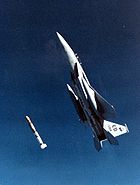 (Image: ASM-135
ASAT test launch)
(Image: ASM-135
ASAT test launch)
From January 1984 to September 1986, two F15As were used as launch platforms for the ASM135 antisatellite (ASAT) missile. The F15As (760086 and 770084) were modified to carry one ASM135 on the centerline station with extra equipment within a special centerline pylon.[35] The launch aircraft executed a Mach 1.22, 3.8 g climb at 65° to release the ASAT missile at an altitude of 38,100 ft (11,600 m).[36][37] The flight computer was updated to control the zoomclimb and missile release. The third test flight involved a retired communications satellite in a 345mile (555 km) orbit, which was successfully destroyed by kinetic energy.[36] The pilot, USAF Major Wilbert D. "Doug" Pearson, became the only pilot to destroy a satellite.[38][37]
The ASAT missile was designed to be a standoff antisatellite weapon, with the F15A acting as a first stage. The Soviet Union could correlate a U.S. rocket launch with a spy satellite loss, but an F15 carrying an ASAT would blend in among hundreds of F15 flights. The ASAT program involved five test launches. The program was officially terminated in 1988.[35][37]
Structural defects
All F15 aircraft were grounded by the U.S. Air Force after a Missouri Air National Guard F15C came apart in flight and crashed on 2 November 2007. The newer F15E fleet was later cleared for continued operations. The U.S. Air Force reported on 28 November 2007 that a critical location in the upper longerons on the F15C model was suspected of causing the failure, causing the fuselage forward of the air intakes, including the cockpit and radome, to separate from the airframe.[39]
F15A through Dmodel aircraft were ordered grounded until the location received more detailed inspections and repairs as needed.[40] The grounding of F15s received media attention as it began to place strains on the nation's air defense efforts.[41] The grounding forced some states to rely on their neighbors' fighter jets for air defense protection, and Alaska to depend on Canadian Forces' support.[41]
On 8 January 2008, the USAF Air Combat Command (ACC) cleared a portion of its F15A through Dmodel fleet for return to flying status. It also recommended a limited return to flight for units worldwide using the affected models.[42] The accident review board report was released on January 10, 2008. The report stated that analysis of the F15C wreckage determined that the longeron did not meet drawing specifications, which led to fatigue cracks and finally a catastrophic failure of the remaining support structures and breakup of the aircraft in flight.[43] In a report released on 10 January 2008, nine other F15s were identified to have similar problems in the longeron. As a result of these problems, General John D. W. Corley stated that "the longterm future of the F15 is in question."[44] On 15 February 2008, ACC cleared all its grounded F15AD fighters for flight pending inspections, engineering reviews and any needed repairs. ACC also recommended release of other U.S. F15AD aircraft.[45]
Future
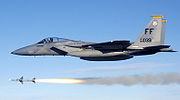 (Image:
F-15C fires AIM-7 Sparrow in 2005.)
(Image:
F-15C fires AIM-7 Sparrow in 2005.)
The F15C/D model is being supplanted in U.S. service by the F22 Raptor. The F15E, however, will remain in service for years to come because of their different airtoground role and the lower number of hours on their airframes.[2] On September 26, 2006, at the Air Force Association's Air & Space Conference and Technology Exposition in Washington D.C., the USAF announced their plan to upgrade 178 F15C fighters with the AN/APG63(V)3 AESA radar. Additionally, the Air Force also plans to upgrade other F15s with the Joint Helmet Mounted Cueing System (JHMCS).[46] In keeping with that plan, the Air Force then contracted with Boeing to retrofit F15Cs with the AN/APG63(V)3 Active Electronically Scanned Array (AESA) radars with delivery beginning in early 2009.[47] The Air Force will keep 178 F15Cs as well as the 224 F15Es in service beyond 2025.[2]
Variants
Basic models
F15A
Singleseat allweather airsuperiority fighter version, 384 built 197279.[48]
 F15B
F15B
Twoseat training version, formerly designated TF15A, 61 built 197279.[48]
(Image: USAF F-15C over Florida)
F15C
Improved singleseat allweather airsuperiority fighter version, 483 built 197985.[48]
F15D
Twoseat training version, 92 built 197985.[48]
F15J
Singleseat allweather airsuperiority fighter version for the Japan Air SelfDefense Force 139 built under license in Japan by Mitsubishi 198197, 2 built
in St. Louis.[48]
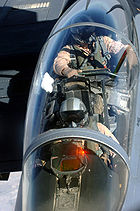 F15DJ
F15DJ
Twoseat training version for the Japan Air SelfDefence Force. 25 Built under license in Japan by Mitsubishi 198197, 12 built in St. Louis.[48]
(Image: A view of an F-15E cockpit from an aerial refueling tanker.)
F15N Sea Eagle
The F15N was a carriercapable variant proposed in the early 1970s to the U.S. Navy as an alternative to the heavier and, at the time, considered
as "riskier" technology
program: F14 Tomcat. The F15NPHX was another proposed naval version capable of carrying the AIM54 Phoenix missile. These featured folding wingtips, reinforced
landing gear and a stronger tail hook for shipboard operation.[49]
Research and test
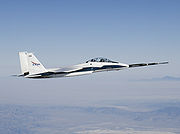 (Image:
NASA's F-15B Research Testbed, aircraft #836 (74-0141), with the Quiet Spike attachment designed to reduce and control a sonic boom.)
(Image:
NASA's F-15B Research Testbed, aircraft #836 (74-0141), with the Quiet Spike attachment designed to reduce and control a sonic boom.)
F15 Streak
Eagle (720119)
One stripped and unpainted F15A, demonstrated the fighter's acceleration – broke eight timetoclimb world records between 16 January and 1 February
1975. It was delivered to the National Museum of the United States Air Force in December 1980.[1]
F15 S/MTD (710290)
The first F15B was converted into a short takeoff and landing, maneuver technology demonstrator aircraft.[50] In the late 1980s it received canard
flight surfaces in addition to its usual horizontal tail, along with square thrustvectoring nozzles. It was used as a shorttakeoff/maneuvertechnology
(SMTD) demonstrator.[51]
F15 ACTIVE (710290)
The F15 S/MTD was later converted into an advanced flight control technology research aircraft with thrust vectoring nozzles.[50]
(Image: Two F-15J Eagles of the 202nd TFS, Japan Air Self-Defense Force, take off in formation during a joint USA/Japan exercise)
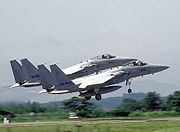 F15
IFCS (710290)
F15
IFCS (710290)
The F15 ACTIVE was then converted into an intelligent flight control systems research aircraft. F15B 710290 is the oldest F15 still flying as of
January 2009.[51]
F15 MANX
Concept name for a tailless variant of the F15 ACTIVE, but the NASA ACTIVE experimental aircraft was never modified to be tailless.
F15 Flight Research Facility (710281 and 710287)
Two F15A aircraft were acquired in 1976 for use by NASA's Dryden Flight Research Center for numerous experiments such as: Highly Integrated Digital
Electronic Control (HiDEC), Adaptive Engine Control System (ADECS), SelfRepairing and SelfDiagnostic Flight Control System (SRFCS) and Propulsion
Controlled Aircraft System (PCA).[52] 710281 was returned to the Air Force and became a static display at Langley AFB in 1983.
Current operators of the F15
Operators
Israel
Israeli Air Force has operated F15s since 1977, received under Peace Fox I, II and III. These aircraft are currently organized into two squadrons of F15A/B and one squadron of F15C/Ds. The first 25 F15A/B were early USAF production airframes,[24] equipping IDFAF squadron 133rd. The second batch was temporarily embargoed as a result of the 1982 Lebanon War.[54]
Japan
Japan Air SelfDefence Force acquired 203 F15Js and 20 F15DJs from 1981, of which 2 F15Js and 12 F15DJs were made in U.S. and the rest by Mitsubishi under license. These aircraft are currently operated by 2 Hikotai (squadron) of 2. Kokudan (Air Wing), Chitose Air Base, 1 Hikotai of 5. Kokudan, Nyutabaru AB, 1 Hikotai of 6. Kokudan, Komatsu AB, 2 Hikotais of 7. Kokudan, Hyakuri AB and 1 Hikotai of 8. Kokudan, Tsuiki AB. In June 2007, the Air SelfDefense Force decided to upgrade certain F15 aircraft with synthetic aperture radar pods; these aircraft will replace RF4 aircraft currently in service.[55]
Saudi Arabia
Royal Saudi Air Force has operated 4 squadrons of F15C/D (55/19) since 1981, received under Peace Sun. They are based at Dhahran, Khamis Mushayt and Taif air bases. A stipulation in the Camp David Peace Agreement limited the number of Saudi F15 to 60, holding surplus air frames in Luke AFB for RSAF pilot training. This limitation was later abandoned.
United States
United States Air Force operated 660 F15 aircraft (515 in active duty and 145 in ANG, active inventory, all variants) as of September 2007.[56] The F15 is being replaced by the newer F22 Raptor.
Active Duty[57]
-Air Combat Command
1st Fighter Wing Langley AFB, Virginia
71st Fighter Squadron
33d Fighter Wing Eglin AFB, Florida
58th Fighter Squadron
53d Wing Eglin Air Force Base, Florida
85th Test and Evaluation Squadron
422d Test and Evaluation Squadron, Nellis AFB, Nevada
57th Wing Nellis AFB, Nevada
65th Aggressor Squadron
366th Fighter Wing Mountain Home AFB, Idaho
390th Fighter Squadron
-Air Education and Training Command
325th Fighter Wing Tyndall AFB, Florida
2d Fighter Squadron
95th Fighter Squadron
-Pacific Air Forces
3d Wing Elmendorf AFB, Alaska
19th Fighter Squadron
18th Wing Kadena AB, Japan
44th Fighter Squadron
67th Fighter Squadron
-United States Air Forces in Europe
48th Fighter Wing RAF Lakenheath, England
493d Fighter Squadron
Air National Guard
-Florida Air National Guard
125th Fighter Wing Jacksonville International Airport
159th Fighter Squadron
-Hawaii Air National Guard
154th Wing Hickam AFB
199th Fighter Squadron
-Louisiana Air National Guard
159th Fighter Wing NAS/JRB New Orleans
122d Fighter Squadron
-Massachusetts Air National Guard
104th Fighter Wing Barnes Municipal Airport
131st Fighter Squadron
-Missouri Air National Guard
131st Fighter Wing Lambert St. Louis Airport (currently converting to B2 Spirit)
110th Fighter Squadron
-Montana Air National Guard
120th Fighter Wing Great Falls International Airport
186th Fighter Squadron
-Oregon Air National Guard
142d Fighter Wing Portland International Airport
123d Fighter Squadron
173d Fighter Wing[58] Kingsley Field
114th Fighter Squadron
Notable accidents and incidents
On 1 May 1983, during an Israeli Air Force training dogfight, an F15D collided with an A4 Skyhawk. Unknown to pilot Zivi Nedivi and his copilot, the right wing of the Eagle was sheared off roughly two feet (60 cm) from the fuselage. The F15 entered an uncontrollable spin after the collision. Zivi decided to attempt recovery and engaged afterburner to increase speed, allowing him to regain control of the aircraft. The pilot was able to prevent stalling and maintain control because of the lift generated by the large horizontal surface area of the fuselage, the stabilators and the surviving right wing. The F15 landed at twice the normal speed to maintain the necessary lift, and its tailhook was torn off completely during the landing. Zivi managed to bring his F15 to a complete stop approximately 20 ft (6 m) from the end of the runway. He was later quoted as saying "(I) probably would have ejected if I knew what had happened."[59][60]
On 19 March 1990, an F15 from the 3rd Wing stationed at Elmendorf AFB, AK accidentally fired an AIM9M Sidewinder missile at another F15. The damaged aircraft was able to make an emergency landing; it was subsequently repaired and returned to service.[61]
On 22 November 1995, during airintercept training over the Sea of Japan, a Japanese F15J flown by Lt. Tatsumi Higuchi was shot down by a AIM9L Sidewinder missile accidentally fired by his wingman in an incident similar to the one that occurred on 19 March 1990. The pilot ejected safely. Both F15Js involved were from JASDF 303rd Squadron, Komatsu AFB.[62]
On 23 March 2001, during a low flying training exercise over the Scottish Highlands, two US Air Force F15Cs crashed near the summit of Ben Macdui in the Cairngorms.[63] Both, Lieutenant Colonel Kenneth John Hyvonen and Captain Kirk Jones died in the accident which would later result in a court martial for an RAF air traffic controller, who was however found not guilty.[64]
On 2 November 2007, a 27yearold F15C (s/n 800034 of the 131st Fighter Wing) crashed during air combat maneuvering training near St. Louis, Missouri. The pilot, Maj. Stephen W. Stilwell, ejected but suffered serious injuries. The crash was the result of an inflight breakup due to structural failure. On 3 November 2007, all nonmission critical models of the F15 were grounded pending the outcome of the crash investigation,[65] and on the following day, grounded nonmission critical F15s engaged in combat missions in the Middle East.[66] By 13 November 2007 over 1,100 were grounded worldwide after Israel, Japan and Saudi Arabia grounded their aircraft as well.[67] F15Es were cleared on 15 November 2007 pending aircraft passing inspections.[68] On 8 January 2008, the USAF cleared 60 percent of the F15AD fleet for return to flight.[42] On 10 January 2008, the accident review board released its report stating the 2 November crash was related to the longeron not meeting drawing specifications.[43] The Air Force cleared all its grounded F15AD fighters for flight on 15 February 2008 pending inspections, reviews and any needed repairs.[45] In March 2008, Stilwell, the injured pilot, filed a lawsuit against Boeing, the F15's manufacturer.[69]
Specifications (F15C Eagle)
General characteristics
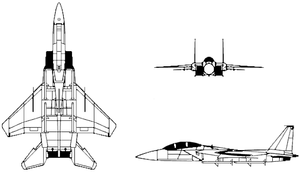 Crew: 1
Crew: 1
Length: 63 ft 9 in (19.43 m)
Wingspan: 42 ft 10 in (13.05 m)
Height: 18 ft 6 in (5.63 m)
Wing area: 608 ft² (56.5 m²)
Airfoil: NACA 64A006.6 root, NACA 64A203 tip
Empty weight: 28,000 lb (12,700 kg)
Loaded weight: 44,500 lb (20,200 kg)
Max takeoff weight: 68,000 lb (30,845 kg)
Powerplant: 2× Pratt & Whitney F100100, 220 or 229 afterburning turbofans
-Dry thrust: 17,450 lbf (77.62 kN) each
-Thrust with afterburner: 25,000 lbf for 220; 29,000 lbf for 229 (111.2 kN for 220; 129.0 kN for 229) each
Performance
Maximum speed:
-High altitude: Mach 2.5+ (1,650+ mph, 2,660+ km/h)
-Low altitude: Mach 1.2 (900 mph, 1,450 km/h)
Combat radius: 1,061 nmi (1,222 mi, 1,967 km) for interdiction mission
Ferry range: 3,450 mi (3,000 nmi, 5,550 km) with conformal fuel tanks and three external fuel tanks
Service ceiling: 65,000 ft (20,000 m)
Rate of climb: ;50,000 ft/min (254 m/s)
Wing loading: 73.1 lb/ft² (358 kg/m²)
Thrust/weight: 1.12 (220), 1.30 (229)
Armament
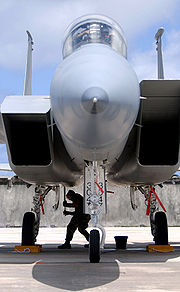 (Image:
An F-15 with intake ramps in different positions)
(Image:
An F-15 with intake ramps in different positions)
Guns: 1× internally mounted 20 mm (0.787 in) M61A1 gatling gun, 940 rounds
Hardpoints: four wing, four fuselage, two wing stations, centerline station, optional fuselage pylons with a capacity of 16,000 lb (7,300 kg),
Missiles:
-AIM7F Sparrow
-AIM120 AMRAAM
-AIM9 Sidewinders
Avionics
Radar:
-Raytheon AN/APG63 or AN/APG70 or
Although several F15C aircraft were produced with APG70 radar, all have been retrofitted to the AN/APG63(V)1 configuration
-Raytheon AN/APG63(V)1 or
-Raytheon AN/APG63(V)2 Active Electronically Scanned Array (AESA) or
-Raytheon AN/APG63(V)3 Active Electronically Scanned Array (AESA)
Both active AF and ANG F15Cs will receive another (up to) 48 V3 units between 20092015, over the existing 19 aircraft.[74]
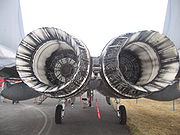 (Image:
Pratt & Whitney F100 turbofan engines of an F-15C Eagle)
(Image:
Pratt & Whitney F100 turbofan engines of an F-15C Eagle)
Countermeasures:
-AN/APX76 or AN/APX119 Identify Friend/Foe (IFF) interrogator
-Magnavox AN/ALQ128 Electronic Warfare Warning Set (EWWS) part of Tactical Electronic Warfare Systems (TEWS)
-Loral AN/ALR56 Radar Warning Receiver (RWR)part of Tactical Electronic Warfare Systems (TEWS)
-Northrop ALQ135 Internal Countermeasures System (ICS) part of Tactical Electronic Warfare Systems (TEWS)
-AN/ALE45 chaff/flare dispensers
Others:
-Joint Helmet Mounted Cueing System[74]
-MXU648 Cargo/Travel Pod to carry personal belongings, and small pieces of maintenance equipment.[48]
Popular culture
The F15 was the subject of the IMAX movie Fighter Pilot: Operation Red Flag, about the RED FLAG exercises. In Tom Clancy's nonfiction Fighter Wing (1995), a detailed analysis of the Air Force's premier fighter aircraft, the F15 Eagle and its capabilities are showcased.[75]
Related development
F15E Strike Eagle
F15 S/MTD
Comparable aircraft
F14 Tomcat
Eurofighter Typhoon
Panavia Tornado ADV
Sukhoi Su27
References
Notes
1. a b McDonnell Douglas F15 Streak Eagle fact sheet, National Museum of the United States Air Force.
2. a b c Tirpak, John A. "Making the Best of the Fighter Force". Air Force magazine, March 2007.
3. "In July 1967 at the Domodedovo airfield near Moscow, the Soviet Union unveiled a new generation of combat aircraft.. condenamed [sic] Foxbat
by NATO.": "Development" in Modern Fighting Aircraft, 1983
4. a b Davies 2002, pp. 9–11.
5. Bowman 1980, p. 193.
6. Davies 2002, pp. 7–9.
7. a b Eden and Moeng 2002, p. 944.
8. Jenkins 1998, p. 10.
9. Jenkins 1998, pp. 9–11.
10. Spick 2000, pp. 130–131.
11. "Return of the Air Superiority Fighter"RAND report.
12. Jenkins 1998, pp. 33–34.
13. a b Green and Swanborough 1998, p. 371.
14. Davies 2002, pp. 56–57.
15. Gunston 1986, p. 194.
16. Huenecke 1987, pp. 227–230.
17. a b Jenkins 1998, pp. 97–104.
18. Huenecke 1987, pp. 232–236.
19. a b Lambert 1993, p. 521.
20. Jenkins 1998, p. 111.
21. Lambert 1993, p. 523.
22. 18 APG63(V)2
23. a b Scutts 1989, p. 47.
24. a b "An Eagle evolves", Boeing, January 2004.
25. "Israeli AirtoAir Victories since 1974", ACIG.org, September 24, 2003.
26. McDonnell Douglas(now Boeing)F15 Eagle Air Superiority Fighter
27. Smith, William E., Pushing the Saudis Too Far, Time, 18 June 1984. Retrieved 26 January 2008.
28. Halloran, Richard, 2 Iranian Fighters Reported Downed by Saudi Air Force New York Times, 6 June 1984, p. 1. Retrieved 26 January 2008.
29. F15 in Saudi Service
30. Davies 2002, pp. 31–40.
31. a b U.S. Air Force Historical Research Agency.
32. 1st. Fighter Wing timeline
33. Patrolling Iraq's Northern Skies.
34. John Correll, "The Reformers", Air Force Magazine, February 2008, Vol. 91 Number 2, p. 44.
35. a b Jenkins 1998, p. 31.
36. a b Karambelas, Gregory and Sven Grahn, ed. The F15 ASAT story. svengrahn.pp.se
37. a b c Grier, Peter. "The Flying Tomato Can". Air Force magazine, February 2009.
38. Biographies: Major General Wilbert D. "Doug" Pearson Jr. USAF, 2 August 2006.
39. Animated image Air Force Magazine February 2008. Retrieved 7 February 2008. Frames from an animated image by Boeing recreating the breakup are here.
40. "F15 AD models ordered to stand down for additional inspections", U.S. Air Force, November 28, 2007.
41. a b Lindlaw, Scott (for Associated Press). "F15 grounding strains U.S. air defenses", ABC News, December 26, 2007.
42. a b "Air Combat Command clears selected F15s for flight", Air Force, January 9, 2008.
43. a b "F15 Eagle accident report released", US Air Force, 10 January 2008. Retrieved 26 January 2008.
44. Buzanowski, J.G. Air Force leaders discuss F15 accident, future US Air Force, January 10, 2008. Retrieved 26 January 2008.
45. a b "ACC issues latest release from stand down for F15s", Air Force, 15 February 2008.
46. Air Force Will Get New Bomber, Upgrades To Fighters, Spacewar.com, 5 October 2006.
47. "Boeing Awarded $70 Million Contract for Enhanced F15C Radar", Boeing, 9 October 2007.
48. a b c d e f g Davies 2002.
49. Jenkins 1998, pp. 71–72.
50. a b Jenkins 1998, pp. 65–70.
51. a b "Sonic Solutions". Aviation Week & Space Technology, 5 January 2009, p. 53. (online version, subscription required)
52. F15 Flight Research Facility fact sheet. Dryden Flight Research Center.
53. F15B Research Testbed fact sheet. Dryden Flight Research Center.
54. Gething 1983
55. "Lockheed Martin to Upgrade Radar for Reconnaissance Version of Japan's F15", Lockheed Martin press release, June 19, 2007.
56. Mehuron, Tamar A., Assoc. Editor. 2008 USAF Almanac, Fact and Figures, Air Force Magazine, May 2008.
57. Air Force Historical Research Agency
58. http://www.173fw.ang.af.mil/
59. No Wing F15 crew stories USS Bennington Retrieved 31 July 2006.
60. F15 flying with one wing by an Israeli pilot
61. Jet Pilot Accidentally Fired Live Missile, Air Force Says. New York Times
62. F15 Eagle Losses and Ejections Retrieved: 2 March 2008.
63. body found at F15 crash site Retrieved 8 March 2009.
64. controller found not guilty Retrieved 8 March 2009.
65. Air Force suspends some F15 operations, U.S. Air Force, 4 November 2007.
66. "Air Force grounds F15s in Afghanistan after Missouri crash", CNN, 5 November 2007.
67. Warwick, Graham. "F15 operators follow USAF grounding after crash." Flight International, 14 November 2007.
68. "Officials begin to clear F15Es to fullmission status", U.S. Air Force, 15 November 2007.
69. Lawsuit
70. F15 Eagle fact sheet, USAF, March 2008.
71. Lambert 1993, p. 522.
72. Davies 2002, Appendix 1.
73. F15 Eagle GlobalSecurity.org. Retrieved 27 January 2008.
74. a b Schanz, Marc V., Assoc. Editor. F15s to Get New Radars "F15s to Get New Radars." Aerospace World: Air Force Magazine, Journal of the
Air Force Association Volume 90, Issue 6, p. 18, December 2007. ISSN: 07306784.
75. Clancy, Tom. Fighter Wing: A Guided Tour of an Air Force Combat Wing. New York: Berkley Books, 1995. ISBN 0425149579.
Bibliography
Bowman, Martin W. US Military Aircraft. London: Bison Books Ltd., 1980. ISBN 0890092923.
Braybrook, Roy. F15 Eagle. London: Osprey Aerospace, 1991. ISBN 1855321491.
Crickmore, Paul. McDonnell Douglas F15 Eagle (Classic Warplanes series). New York: Smithmark Books, 1992. ISBN 0831714085.
Davies, Steve. Combat Legend, F15 Eagle and Strike Eagle. London: Airlife Publishing, Ltd., 2002. ISBN 1840373776.
Drendel, Lou. Eagle (Modern Military Aircraft Series). Carrollton, Texas: Squadron/Signal Publications, 1985. ISBN 0897471681
Drendel, Lou and Don Carson. F15 Eagle in action. Carrollton, Texas: Squadron/Signal Publications, 1976. ISBN 0897470230.
Eden, Paul and Soph Moeng, eds. The Complete Encyclopedia of World Aircraft. London: Amber Books Ltd., 2002. ISBN 0760734321.
Fitzsimons, Bernard. Modern Fighting Aircraft, F15 Eagle. London: Salamander Books Ltd., 1983. ISBN 0861011821.
Gething, Michael J. F15 Eagle (Modern Fighting Aircraft). New York: Arco, 1983. ISBN 0668059028.
Gething, Michael J. and Paul Crickmore. F15 (Combat Aircraft series). New York: Crescent Books, 1992. ISBN 051706734X.
Green, William and Gordon Swanborough. The Complete Book of Fighters. New York: Barnes & Noble Inc., 1988. ISBN 00760709041.
Gunston, Bill. American Warplanes. New York: Crescent Books. 1986. ISBN 0517613514.
Huenecke, Klaus. Modern Combat Aircraft Design. Annapolis, Maryland: Naval Institute Press, 1987. ISBN 0870214268.
Jenkins, Dennis R. McDonnell Douglas F15 Eagle, Supreme HeavyWeight Fighter. Arlington, TX: Aerofax, 1998. ISBN 1857800818.
Kinzey, Bert. The F15 Eagle in Detail & Scale (Part 1, Series II). El Paso, Texas: Detail & Scale, Inc., 1978. ISBN 0816850283.
Lambert, Mark, ed. Jane's All the World's Aircraft 199394. Alexandria, Virginia: Jane's Information Group Inc., 1993. ISBN 0710610661.
Scutts, Jerry. Supersonic Aircraft of USAF. New York: Mallard Press, 1989. ISBN 0792450132.
Spick, Mike. The Great Book of Modern Warplanes. St. Paul Minnesota: MBI, 2000. ISBN 0760308934.
Living Warbirds: The best warbirds DVD series.
Source: WikiPedia